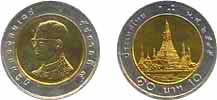Thai coins lack the color of the bank notes, but still vary widely in size and design. The pictures below show the current versions of the coins that you are likely to encounter. In addition to these, a two-Baht coin was introduced in 2007. The coin is only slightly larger than the one-Baht coin, and the designs are also very similar, so there is often a lot of confusion caused by the new coin. So much so that many cashiers don't give them out, and when you do manage to get one, you'll frequently find that a "2" has been written on one of the faces. Later batches sport a brass color to help distinguish them from one-Baht coins.

The 10-Baht coin
The standard 10-Baht coin is a silver ring with a brass center. The coin replaced a 10-Baht bill in the early 1990's but you still run across bills from time to time.
The back of the standard 10-Baht coin depicts Wat Arun, but there are numerous commemorative versions of the coin in circulation. At times, it seems as though the Kanchanapisek version is more common than the standard coin.

Five-Baht Coin
The Five-Baht coin is slightly smaller than the 10-Baht piece. The reverse features Wat Benjamabophit. There's also a Kanchanapisek version of this coin.

One-Baht Coin
The one-Baht coin is silver and slightly larger than a US cent. Like the five and ten-Baht coins, there's also a Kanchanapisek version commonly found.
The back of the one-Baht coin displays the chedis of the Temple of the Emerald Buddha.

50-Satang Coin
The 50-Satang (one-half of one Baht) piece is a small brass coin about the size of a US dime. The back features the chedi at Wat Prathat Doi Suthep in Chiang Mai.

25-Satang Coin
The 25-Satang piece is a tiny brass coin. Both the 25- and 50-Satang coins are rather useless. Once received they are almost impossible to get rid of. Tourists will rarely encounter either coin, since they are mostly used in supermarkets and convenience stores. Shops and restaurants work in full-Baht prices only.